EXAMPLE PROBLEMS OF ANGLE OF ELEVATION AND DEPRESSION
Subscribe to our ▶️ YouTube channel 🔴 for the latest videos, updates, and tips.
Example 1 :
A boy standing on the ground, spots a balloon moving with the wind in a horizontal line at a constant height . The angle of elevation of the balloon from the boy at an instant is 60°. After 2 minutes, from the same point of observation, the angle of elevation reduces to 30°. If the speed of wind is 29√3 m/min. then, find the height of the balloon from the ground level.
Solution :
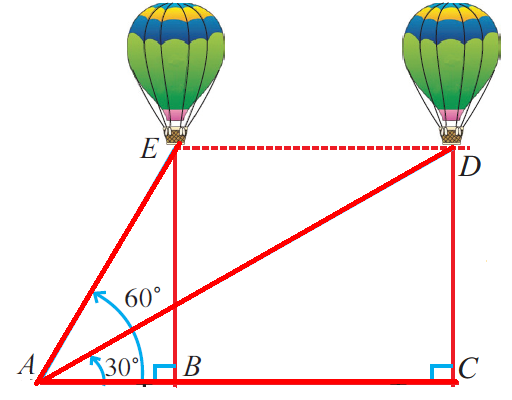
Distance covered by the balloon = BC
BC = Time x Speed ==> 2 x 29 √3 ==> 58√3 m
AB = x then AC = x + 58√3
In triangle DAC :
∠DAC = 30°
tan θ = opposite side/Adjacent side
tan 30° = DC/AC
1/√3 = DC/(x + 58√3)
DC = (x + 58√3)/√3 ----(1)
In triangle EAB :
∠EAB = 60°
tan θ = opposite side/Adjacent side
tan 60° = EB/AB
√3 = EB/x
x√3 = EB
EB = √3x ---->(2)
Since EB = DC
(1) = (2)
(x + 58√3)/√3 = √3x
x + 58√3 = 3x
3x - x = 58√3
2x = 58√3
x = 58√3/2 ==> 29√3 m
Height of the balloon from ground level EB = √3 x
= 29 √3 (√3)
= 29(3) ==> 87 m
Hence height of the balloon from ground level = 87 m.
Example 2 :
A straight highway leads to the foot of a tower . A man standing on the top of the tower spots a van at an angle of depression of 30°. The van is approaching the tower with a uniform speed. After 6 minutes, the angle of depression of the van is found to be 60°. How many more minutes will it take for the van to reach the tower?
Solution :
From the given information, we can draw a rough diagram
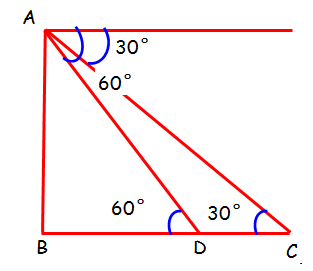
Distance covered by the van to reach D from C = 6 minutes
time taken = x
Distance between D and C = 6x
In triangle ACB
∠ACB = 30°
tan θ = opposite side/Adjacent side
tan 30° = AB/BC
1/√3 = AB/(BD+DC)
1/√3 = AB/(BD+6x)
(BD+6x)/√3 = AB ----(1)
In triangle ABD
∠ABD = 60°
tan θ = opposite side/Adjacent side
tan 60° = AB/BD
√3 = AB/BD ==> AB = BD√3 -----(2)
(1) = (2)
(BD+6x)/√3 = BD√3
BD + 6x = BD(3)
3BD - BD = 6x
2BD = 6x
BD = 6x /2 = 3x
Here 3 represents number of minutes covered by the van and x stands for time taken.
Hence 3 more minutes will it take for the van to reach the tower.
Example 3 :
A man flies a kite with a 100 foot string. The angle of elevation of the string is 52 degree. How high off the ground is the kite ?
Solution :
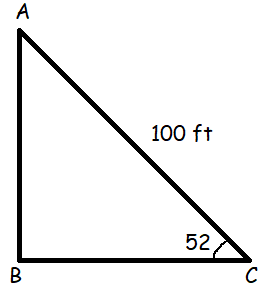
AB = Opposite side
BC = Adjacent side
AC = Hypotenuse
sin θ = opposite side/Hypotenuse
sin 52 = AB/AC
0.788 = AB/100
AB = 0.788(100)
= 78.8 ft
So, height of the kite is at 78.8 ft.
Example 4 :
From a plane flying due east at 265 m above sea level, the angles of depression of two ships sailing due east measure 35° and 25°. How far apart are the ships ?
Solution :
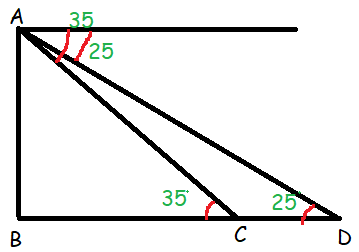
AB = 265 m = Opposite side
BC and BD are adjacent sides
AC and AD are hypotenuse
In triangle ABC,
tan θ = opposite side/adjacent side
tan 35 = AB/BC
tan 35 = 265 / BC
BC = 265/tan 35
BC = 265/0.700
BC = 378.57
In triangle ABD,
tan θ = opposite side/adjacent side
tan 25 = AB/BD
tan 25 = 265 / (BC + CD)
BC + CD = 265/tan 25
378.57 + CD = 265/0.466
378.57 + CD = 568.66
CD = 568.66 - 378.57
CD = 190.09
So, the ships are at 190.09 ft apart.
Example 5 :
From the top of a vertical cliff 40 m high, the angle of depression of an object that is level with the base of the cliff is 34 degree. How far is the object from the base of the cliff ?
Solution :
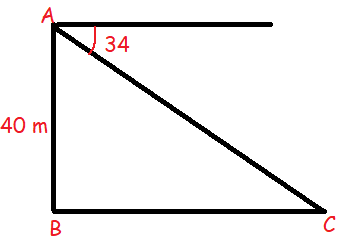
Using parallel lines and transversal, <ACB = 34
AB = Opposite side
BC = Adjacent side
AC = Hypotenuse
tan 34 = AB/BC
tan 34 = 40/BC
BC = 40/tan 34
BC = 40/0.674
BC = 59.34
So, the distance between the base of the cliff is 59.34 ft approximately.
Example 6 :
A TV tower stands vertically on a bank of a canal. The tower is watched from a point on the other bank directly opposite to it. The angle of elevation of the top of the tower is 58°. From another point 20 m away from this point on the line joining this point to the foot of the tower, the angle of elevation of the top of the tower is 30°. Find the height of the tower and the width of the canal. (tan 58° = 1.6003)
Solution :
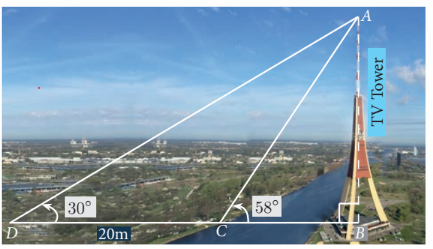
In triangle ABC,
tan 58 = AB/BC
1.600 = AB/BC
AB = BC (1.6) --------(1)
In triangle ADB,
tan 30 = AB/BD
0.577 = AB/(BC + CD)
AB = 0.577(BC + CD)
AB = 0.577(BC + 20) --------(2)
(1) = (2)
Width of the canal :
BC (1.6) = 0.577(BC + 20)
(1.6 - 0.577) BC = 20(0.577)
1.023 BC = 11.54
BC = 11.54/1.023
BC = 11.28
So, width of the canal is 11.28 m
Height of the tower :
AB = BC (1.6)
AB = 11.28(1.6)
AB = 18.04 m
So, height of the tower is 18.04 m
Subscribe to our ▶️ YouTube channel 🔴 for the latest videos, updates, and tips.
Kindly mail your feedback to v4formath@gmail.com
We always appreciate your feedback.
©All rights reserved. onlinemath4all.com
Recent Articles
-
SAT Math Practice
Dec 05, 25 04:04 AM
SAT Math Practice - Different Topics - Concept - Formulas - Example problems with step by step explanation -
10 Hard SAT Math Questions (Part - 37)
Dec 03, 25 07:02 AM
10 Hard SAT Math Questions (Part - 37) -
Factorial Problems and Solutions
Dec 02, 25 09:27 AM
Factorial Problems and Solutions

